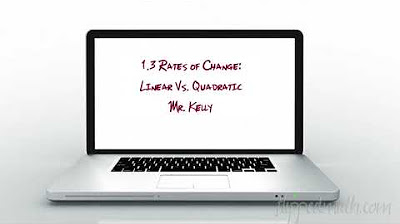KUPAS TUNTAS VERB 1, 2 DAN 3 DALAM BAHASA INGGRIS - Kampung Inggris LC
Summary
TLDRIn this tutorial, Mr. Yaya explains the use of different verb forms (Verb 1, Verb 2, Verb 3) in English tenses, specifically focusing on Simple Present, Simple Past, and Present Perfect. He provides clear examples for each tense, highlighting the importance of verb changes depending on the context. Verb 1 is used for habits and facts, Verb 2 for past actions, and Verb 3 for ongoing actions from the past with present relevance. The lesson also covers the correct usage of 'do,' 'does,' 'did,' 'has,' and 'have' in negative and interrogative sentences. A helpful guide for English learners looking to master verb tense usage.
Takeaways
- 😀 Verb 1 is used for habits, routines, or facts in the present, forming sentences in the simple present tense (e.g., 'I eat bread every day').
- 😀 In negative sentences with verb 1, 'do not' or 'does not' is added (e.g., 'I do not eat bread every day').
- 😀 For interrogative sentences with verb 1, 'do' or 'does' is placed at the beginning (e.g., 'Do you eat bread every day?').
- 😀 The difference between 'do' and 'does' is based on the subject: use 'do' for I, you, we, and they, and 'does' for he, she, and it.
- 😀 Verb 2 is used for actions completed in the past, in the simple past tense, and verbs are typically changed (e.g., 'I ate bread last night').
- 😀 In negative sentences with verb 2, 'did not' is used, and after 'did not,' the base form of the verb is used (e.g., 'I did not eat bread last night').
- 😀 For questions in the past tense, 'did' is placed at the beginning of the sentence (e.g., 'Did you eat bread last night?').
- 😀 Verb 3 is used in the present perfect tense, indicating actions that began in the past and continue into the present (e.g., 'He has eaten bread for two years').
- 😀 In present perfect sentences, 'have' is used for I, you, we, and they, while 'has' is used for he, she, and it.
- 😀 Time signals like 'for' (duration) and 'since' (specific point in time) are important for present perfect tense (e.g., 'He has eaten bread for two years' vs. 'He has eaten bread since 2015').
Q & A
What is the primary use of verb 1 in English grammar?
-Verb 1, or the base form of a verb, is used primarily for expressing habits, routines, or facts in the simple present tense.
Can you give an example of verb 1 used in a sentence?
-Sure! An example would be: 'I eat bread every day.' Here, 'eat' is verb 1, indicating a routine or habit.
What is the difference between 'do' and 'does' in negative and interrogative sentences?
-'Do' is used with subjects like 'I', 'you', 'we', and 'they', while 'does' is used with singular third-person subjects like 'he', 'she', or 'it'. Both are used to form negative and interrogative sentences in the simple present tense.
How do you form negative sentences with verb 1?
-To form a negative sentence with verb 1, you add 'do not' (or 'don't') for subjects like 'I', 'you', 'we', 'they', or 'does not' (or 'doesn't') for third-person singular subjects. For example, 'I do not eat bread every day.'
When do you use verb 2 in English grammar?
-Verb 2, or the past form of a verb, is used to describe actions that occurred and were completed in the past. It is typically used in the simple past tense.
Can you provide an example of verb 2 in a sentence?
-Certainly! For example: 'I ate bread last night.' Here, 'ate' is verb 2, showing a past action.
How do you form negative sentences with verb 2?
-For negative sentences in the simple past tense, 'did not' (or 'didn't') is used with the base verb. For example, 'I did not eat bread last night.'
What is the role of verb 3 in English grammar?
-Verb 3, or the past participle, is used in the present perfect tense to describe actions that started in the past and continue into the present.
Can you give an example of verb 3 used in a sentence?
-Of course! An example would be: 'He has eaten bread for two years.' Here, 'eaten' is verb 3, indicating an action that started in the past and is still ongoing.
What is the difference between 'for' and 'since' in the present perfect tense?
-'For' is used to talk about the duration of an action, like 'for two years', while 'since' is used to indicate the starting point of the action, such as 'since 1994' or 'since Monday'.
Outlines

此内容仅限付费用户访问。 请升级后访问。
立即升级Mindmap

此内容仅限付费用户访问。 请升级后访问。
立即升级Keywords

此内容仅限付费用户访问。 请升级后访问。
立即升级Highlights

此内容仅限付费用户访问。 请升级后访问。
立即升级Transcripts

此内容仅限付费用户访问。 请升级后访问。
立即升级浏览更多相关视频

Motion Characteristics of a Projectile

AP Precalculus – 1.3 Rates of Change Linear and Quadratic Functions

CARA MUDAH BEDAIN THEY, THEY’RE, THEIR, DAN THERE - Kampung Inggris LC | Teatu

Create checkerboard pattern in Photoshop tutorial how to

How to Add, Subtract, Multiply, and Divide Decimals | A Review of Decimals | Math with Mr. J

(BOCORAN) SOAL TES MASUK SMP/MTs‼️PART 1

How to Find the Surface Area of a Rectangular Prism | Math with Mr. J
5.0 / 5 (0 votes)
